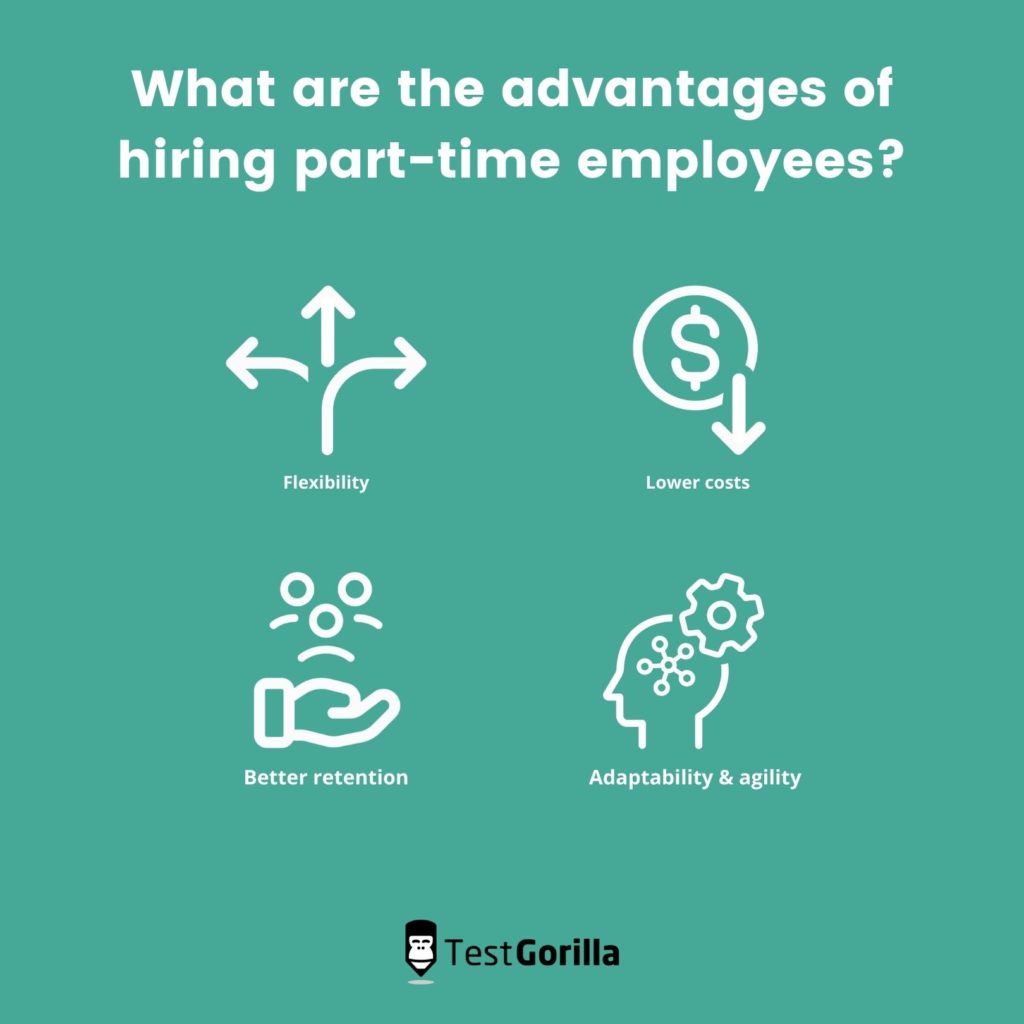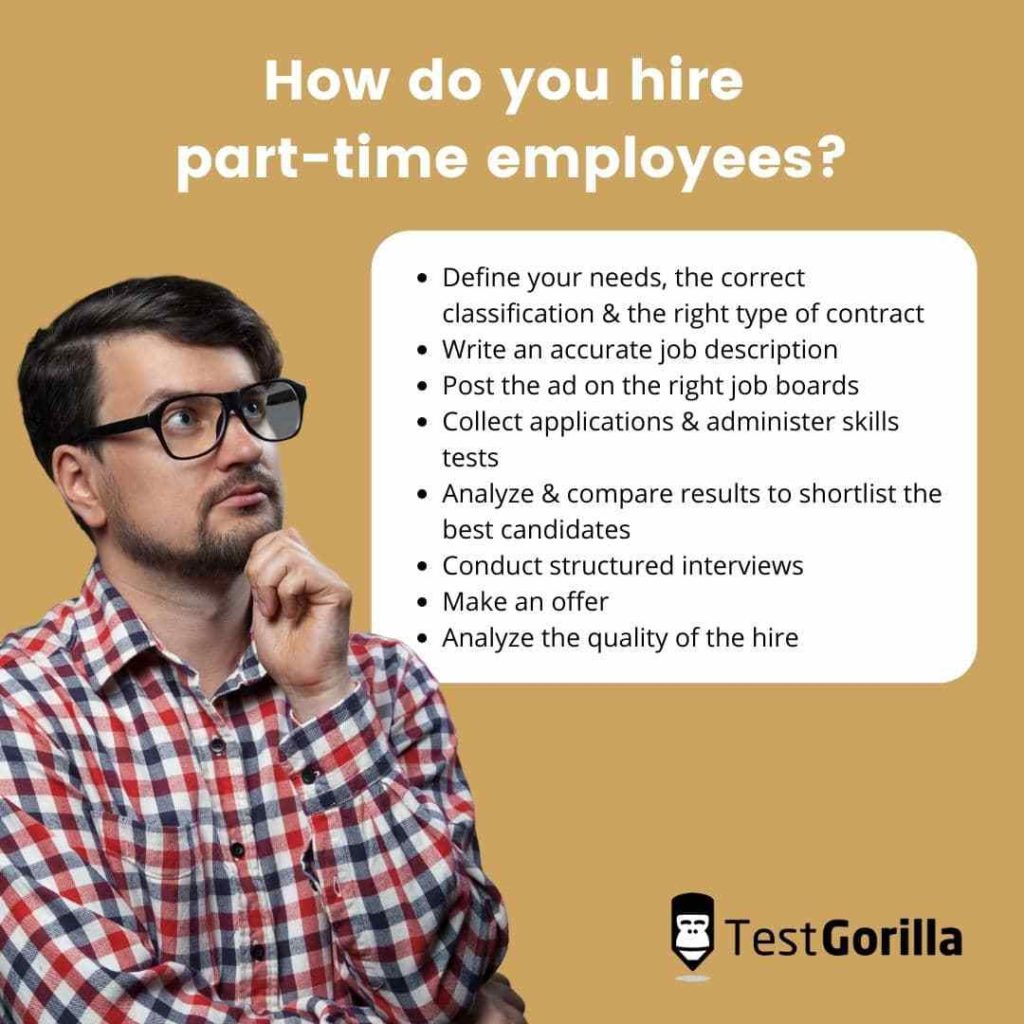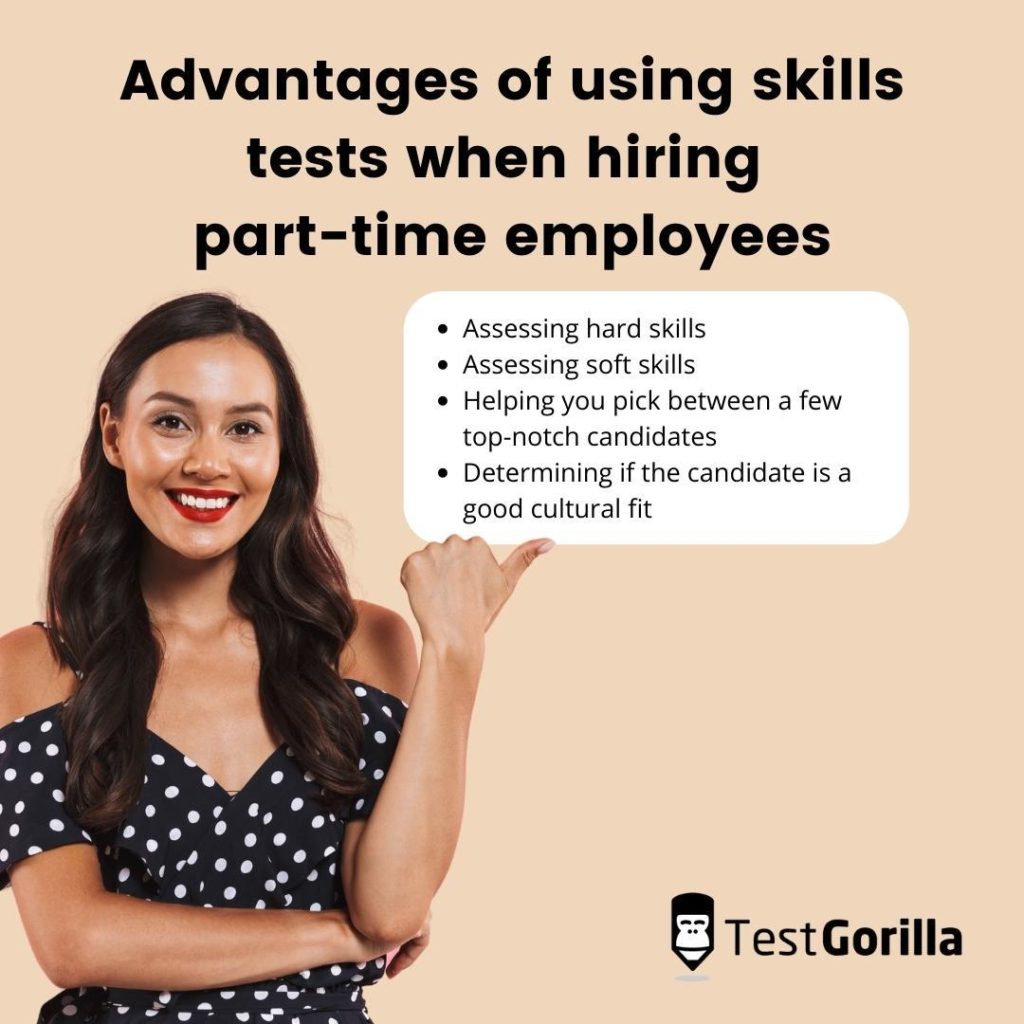The number of people looking for a part-time job is increasing. According to Statista, roughly 25 million Americans were working part-time between August 2020 and August 2021.
Part-time gigs are no longer seen as less desirable than full-time employment, and many businesses are hiring part-time workers. The job board FlexJobs published an article about the 50 companies that post part-time listings most frequently, and it contains big names like Apple, Telus International, and the American Red Cross.
If your business is hiring part-time employees, it’s crucial to make the right choice, regardless of what position you’re looking to fill. Employee turnover may cause significant losses, even when they’re part-time workers.
While there are ways to reduce employee turnover, making the right hire plays a vital role in keeping the work process intact and boosting the performance of your organization. To help you achieve this, our step-by-step guide will include information about:
The correct classification of part-time employees and contracts
Writing an accurate job description that will attract the right people
Posting ads on job boards
The advantages of conducting skills assessments before hiring employees
How to analyze and compare results
Conducting structured interviews
Making a suitable offer
Analyzing the quality of your hire
But first, let’s talk about why hiring part-time employees is a good idea for your business.
Table of contents
What are the advantages of hiring part-time employees?
With the global COVID-19 pandemic continuing, more people are looking to reinvent their careers than ever. Part-time jobs offer a great opportunity to do that. And employers can benefit from them, too — here are some examples that show why.
1. Flexibility, for you and for your employees
Ninety-six percent of US professionals say they need flexibility in their job, but only 47% have it. Part-time jobs offer employees the opportunity to rearrange their schedules and everyday life more freely. A large number of the people looking for part-time jobs have other responsibilities and they prefer a career that offers them flexibility.
Employers can benefit greatly from that, too: hiring part-time workers and scheduling them on an as-needed basis helps you keep up with demand spikes without redundancies during slower periods. Most businesses need someone to cover the shifts that full-time employees can’t or have job positions that don’t require a full-time worker.
2. Lower costs
First, paying for fewer hours of work is cheaper. A more efficient schedule can save your business a lot in expenses. Second, you can often cut costs further because it’s not always required to pay certain benefits for part-time employees. Make sure to check your local laws, though!
3. Better retention
Flex-time is of great importance for employees with families. Making the workplace more family-friendly provides for better retention and is good for your business.
You can also support overstretched full-time employees and take things off their plate by hiring part-time workers who can fill in the gaps. The main reason people are quitting their jobs is burn-out, so when you reduce your loyal employees’ workload, you’re allowing them to deal better with the stress and to get enough rest.
4. Adaptability & agility
With part-time employees, you can better adapt to demand (such as seasonal fluctuation, events, etc.) and be more agile. Part-time employees allow you to improve your overall performance and reduce costs by adjusting your business more easily to changing conditions.
How do you hire part-time employees?
For any recruiter, it’s important to keep the hiring process as organized as possible. If you don’t complete all the necessary steps, you risk hiring an ill-suited candidate, which can be very costly. It’s also important to minimize the time and resources you put into finding the right employee.
To optimize the process of hiring part-time employees, follow these steps:
1. Define your needs, the correct classification & the right type of contract
It’s important to explain clearly and in detail what your expectations are. It’s best to make these things clear from the start: that way you’re going to filter out a lot of unsuitable candidates early on.
The correct worker classification will determine if you must withhold taxes to pay things like Social Security. You need to pay these for employees, but not for independent contractors. How to tell the difference? As stated by the IRS, the general rule is that with contractors you can’t control how they deliver the end product.
You may need to offer a part-time contract. The US Department of Labor defines this as working 34 hours or less per week, but this definition is only used to gather statistical data and is more flexible in practice.
2. Write an accurate job description
Don’t make the mistake of thinking there isn’t a need to put effort into writing the right job description just because it’s for a part-time position. If you want to hire quality employees, make sure your job ad is good:
Be as precise as possible. Use detailed language but stick to the point.
Specify the working hours and days. There are reasons why some people choose to work part-time: usually, they have other responsibilities they need to attend to. So make sure to specify how many days and hours per week you need your employee to work, as well as any other preferences you have. For example, you could set out which days you need them to work, and whether they have to work on weekends, holidays, or outside the usual business hours.
Be mindful of any gender-specific words you might be using unintentionally. It’s important to keep the working environment free from bias.
Outline any specific skills you require. As with full-time work, most part-time positions require certain traits, experience, and educational achievements.
3. Post the ad on the right job boards
When it comes to picking the right job board for a part-time job posting, it’s important to know that picking a popular one isn’t always the best choice. People who look for part-time gigs often go through sites other than those looking for a full-time position. Target the niche websites that cater to them. Here are some examples:
Freelancer.com offers a great variety of options when you’re looking for a temporary remote worker or a contractor. All you need to do is describe the project that needs to be managed and select suitable candidates.
FlexJobs has a section dedicated to finding part-time and remote candidates. You can post your job for $299 per month and find really good candidates.
CoolWorks is a job board founded in 1995. Many people look for seasonal jobs there, which makes it the perfect spot for hiring part-time employees.
Craiglist makes attracting temporary workers very simple. It has a ‘Gigs’ filter that lets you find part-timers easily. Just write the details for the position you’re looking to fill and you can start sourcing people for the vacancy in your company.
4. Collect applications & administer skills tests
By now, you have probably gathered a serious number of applications. If you want to optimize the selection process, you can implement pre-employment skill tests. They are really helpful when it comes to narrowing down your candidate selection, so you can pick the one that fits your organization’s needs the best. This is why 82% of companies use pre-employment assessments.
Some of the advantages of using skills tests are:
Assessing hard skills: When hiring new employees, it’s important to be able to assess role-specific skills reliably, and not just rely on CVs or on gut feeling (which is simply another word for bias). Skills tests allow you to do that.
Assessing soft skills: It’s essential to find out whether the candidate not only has hard skills connected to the position but also meets your other requirements. For example, pre-employment tests can help you evaluate the communication or problem-solving skills of your prospective hire.
Helping you pick between a few top-notch candidates: If you have a few great candidates, it might be difficult to make a choice. Pre-employment tests help you assess the individual qualities of each candidate.
Determining if the candidate is a good cultural fit: It’s not just the skills that matter but also whether your organization and your potential employee are on the same page. Do they share the same values as their team or the company?
When you’re administering pre-employment tests in the recruiting process, there are a few steps it’s important to follow for maximum productivity:
Look for the right job-specific tests. Every position requires a certain skill set. The best way to find if the potential candidates fit the criteria is by testing them through specialized tools. You can pick the job type and choose a test type. For example, cognitive ability tests help you determine how good your candidate is at intermediate math, verbal reasoning, or reading comprehension. This article can help you determine the tests that will be helpful for you.
Find out if your candidate is a cultural fit for your organization. The culture add test determines without bias whether someone’s values, behavior patterns, and interests align with your company’s values.
Your prospective employee’s personality plays a part in how well they fit the position, too. It’s not necessary, but it’s recommended to see if they are a personality fit. You can use the 16 personalities test, based on the work of renowned psychologist Carl Jung, or the Enneagram test, which describes nine personality types and their specific core values.
5. Analyze & compare results to shortlist the best candidates
After you’re done with skills testing, you need to compare the results and see which candidates meet your requirements.
It’s quite likely that some might perform better in one aspect, while others excel in another. When analyzing pre-employment test results, it’s important to keep in mind that what you’re looking for is a healthy balance between skills, cultural fit, and personality fit, and that the results are not meant to replace the decision-making process, but rather to complement it. They exist only to help you make a more informed choice!
6. Conduct structured interviews
So, now you’re only left with a few top candidates to interview. To optimize your time and learn what you need about your potential employee, it’s good practice to prepare your questions ahead and develop a system by which you can score their results after you’re finished interviewing them, by using a structured interviewing process.
There are two types of structured interviews: behavioral and situational. You can learn more about them and how to conduct them by reading our interview guide template.
7. Make an offer
Once you find the perfect hire for the part-time position in your company, it’s time to make an offer:
Make the offer over the phone first. If the candidate has already found another gig or is no longer interested in the job, this will save you the time you would’ve spent preparing the offer and crafting the letter otherwise.
Use effective offer letter templates to speed up the process. Make sure they include all the necessary details.
8. Analyze the quality of the hire
There is no one-size-fits-all method of assessing the quality of your hire. There are standard metrics such as cost-per-hire and time-to-hire but you may also include other criteria depending on your company’s needs and values. When it comes to new employees, it’s always a good idea to keep track of their productivity stats to ensure they are improving over time.
Conclusion
Regardless of whether you’re hiring part-time or full-time employees, the recruitment process can be quite a challenge. Picking the right candidate who’s a good cultural and personality fit for your company and has the right skill set for each position is difficult, but you can optimize the process with skills tests, which reduce the necessary time-to-hire and make the hiring process less resource-intensive.
Hiring part-time employees? Check out TestGorilla’s pre-employment skills tests today for free and make better hiring decisions, faster and bias-free.
Related posts
Hire the best candidates with TestGorilla
Create pre-employment assessments in minutes to screen candidates, save time, and hire the best talent.
Latest posts
The best advice in pre-employment testing, in your inbox.
No spam. Unsubscribe at any time.

Hire the best. No bias. No stress.
Our screening tests identify the best candidates and make your hiring decisions faster, easier, and bias-free.
Free resources
This checklist covers key features you should look for when choosing a skills testing platform
This resource will help you develop an onboarding checklist for new hires.
How to assess your candidates' attention to detail.
Learn how to get human resources certified through HRCI or SHRM.
Learn how you can improve the level of talent at your company.
Learn how CapitalT reduced hiring bias with online skills assessments.
Learn how to make the resume process more efficient and more effective.
Improve your hiring strategy with these 7 critical recruitment metrics.
Learn how Sukhi decreased time spent reviewing resumes by 83%!
Hire more efficiently with these hacks that 99% of recruiters aren't using.
Make a business case for diversity and inclusion initiatives with this data.






















